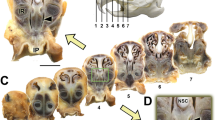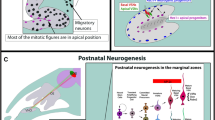Abstract.
In contrast to many lower vertebrates, the vomeronasal epithelium (VNE) in humans has long been regarded as absent or functionally irrelevant. For example, the neural connection between the VNE and the accessory olfactory bulb has been reported to degenerate during the second half of pregnancy and its presence has not been demonstrated in adults. Further, reports on the organ's occurrence in adult humans have been contradictory. The aims of this study were to collect immunohistochemical data on the neurogenic or epithelial character of the VNE [for example, with antibodies against protein gene product 9.5 (PGP 9.5), olfactory marker protein (OMP), β-tubulin, and cytokeratin], determine its proliferative capacity (for example, proliferating cell nuclear antigen), as well as to examine the differentiation activity of VNE cells and their interactions with extracellular matrix components (for example, hyaluronan receptor CD44, galectins, and caveolin). To this end, we studied the vomeronasal organs (VNOs) of 22 human cadavers, three adult biopsies, one embryo (week 8) and one fetus (week 13) by means of immunohistochemistry. The histology of the VNE appeared extremely heterogeneous. There were sections of stratified, respiratory, and typical "pseudostratified" vomeronasal epithelia consisting of slender bipolar cells. Mostly negative immunohistochemical results for OMP indicated that the human VNE does not function like the mature olfactory epithelium. In addition, the investigations did not support the hypothesis that neural connections between the VNE and central brain structures might be present. On the other hand, the presence of some bipolar cells positive for both PGP 9.5 and soybean lectin (SBA) pointed to a neuron-like activity of a small subset of VNE cells. Proliferation antigens located in the nuclei of basally located cells of the VNE were not regularly expressed. However, positive reactions for CD44 demonstrated a high activity of VNE cells in terms of differentiation and migration. Some bipolar cells showed immunoreactivity for caveolin indicating its possible role in signal transduction and differentiation. In summary, the reaction patterns of most antibodies in the adult human VNE are different from those obtained in the olfactory epithelium and the VNO of the rat. However, the VNE shows a specific pattern of activity unique to the mucosa of the nasal cavity. Considering the histologically well differentiated epithelium and its steady maintenance, the VNE of the adult human appears to be a highly differentiated structure the function of which remains unclear.
Similar content being viewed by others
Author information
Authors and Affiliations
Additional information
Electronic Publication
Rights and permissions
About this article
Cite this article
Witt, M., Georgiewa, B., Knecht, M. et al. On the chemosensory nature of the vomeronasal epithelium in adult humans. Histochem Cell Biol 117, 493–509 (2002). https://doi.org/10.1007/s00418-002-0407-1
Accepted:
Published:
Issue Date:
DOI: https://doi.org/10.1007/s00418-002-0407-1




